Urogenital System
CONTENTS:
List of Anomalies:
• Female tract anomalies
• Crytorchid testes
• Mammary teat anomalies
• Kidney and urinary tract anomalies
Anomalies Commentary:
Male and female genital systems arise from two parallel duct systems. The mesonephoric duct system of males is derived from the ducts of the mesonephroric kidneys which are replaced by the definitive metanephoric kidneys. The paramesonephoric ducts of the female develop parallel to the mesonephoric ducts. Both ducts are present in the embryo but one duct system will atrophy as the other develops into the definitive genitalia according to the inherited genetic sex and resulting testicular hormones. Occasionally remnants of the opposite sex may persist or the paramesonephoric ducts may not fuse properly resulting in an anomaly.
The paramesonephoric ducts give rise to the uterine tubes (oviducts), uterine horns and body, cervix and cranial vagina. Fusion of the paramesonephic ducts gives rise to a single uterine body, cervix and vagina in most mammals. The degree of fusion varies greatly among mammals being greatest in primates and least in marsupials. From greatest to least fusion: primates > horse > ruminants > pig & carnivores > rabbit. Therefore, the body of the uterus is better developed in the mare and poorly developed in sow, bitch and queen.
According to Greek mythology, Hermaphroditus was the son of Hermes and Aphrodite. A goddess was so attracted to him that she entreated the gods to become permanently fused to him, hence the male/female fusion. True hermaphrodites contain gonads of both sexes, or more commonly, an ovatestis. Pseudohermaphrodites have a gonad of one sex but have ambiguous external genitalia. Therefore, both male and female pseudohermaphrodites occur. The term intersex is more commonly used than hermaphrodite, perhaps because it is easier to say and spell. Some hermaphrodrodites are the result of hormonal action as in the case of so-called freemartins. These are intersex genetic female calves born co-twin to a bull calf. Due to anastomosis of their placental vessels, a hormone known as Mullerian Inhibitory Factor is passed from the male calf to the female. This hormone inhibits development of the paramesonephoric (Mullerian) ducts.
Cryptorchidism refers to a hidden (cryptic) testicle. Orchid refers to the testicle. The condition is more commonly unilateral than bilateral. The cryptic testicle can be in the abdomen or the inguinal canal (high flanker). The most famous former cryptochid is Funnycide, the gelding who almost won the Triple Crown in 2003. He was gelded due to a unilateral cryptorchid testicle. If only the cryptic testicle was removed he would have been fertile but could have passed on the defect so castration was the ethical choice. However, there is little evidence that the trait is heritable in horses.
Cryptorchidism is the result of failure of testicular descent, the process by which the testicles descend from the abdomen into the scrotal sac. The gubernaculum testis pulls the testis to the inguinal canal; subsequently, elevated pressure pops the testis into the scrotal sac. The gubernaculum shortens due to pumping water out of its gelatinous matrix.
As descent of the testis occurs, the epididymis organizes and becomes closely associated with the testis proper so that the two are joined in the descended testicle. In abdominal cryptorchids there is less association between the testis and the epididymis but in inguinal cryptorchids the epididymis is closer related to the testis.
Testicular descent occurs to permit cooling of the testis. Cryptorchid testicles are small in size because at body temperature the germinal epithelium of the seminiferous tubules is reduced to a single layer. Body temperature does not affect growth of testosterone producing interstitial (Leydig) cells so a bilateral cryptochid stud will appear to be gelded but will have stud like behavior. Cooling of the testicle keeps the sperm inactive. They are activated by body temperature once delivered to the female genital tract. A high fever can elevate scrotal temperature enough to cause temporary infertility.
Anomaly Images:
Note: Click an image to see it enlarged, view its caption, and toggle its labels.
| 1 |  |
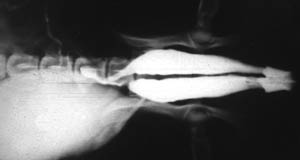 |
2 |
| 3 |  |
 |
4 |
| 5 | 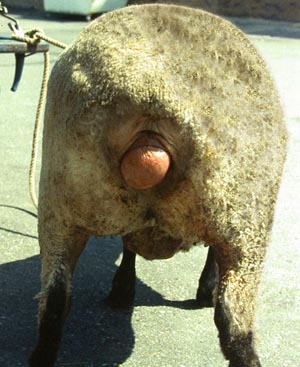 |
 |
6 |
| 7 | 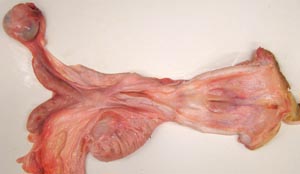 |
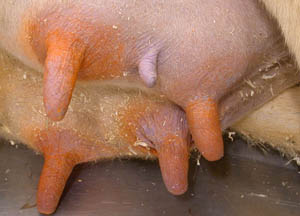 |
8 |
| 9 |  |
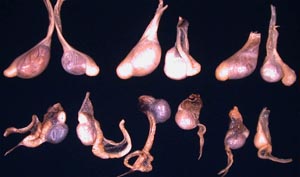 |
10 |
| 11 | 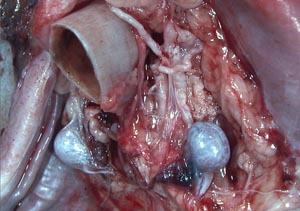 |
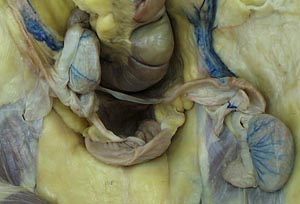 |
12 |
| 13 | 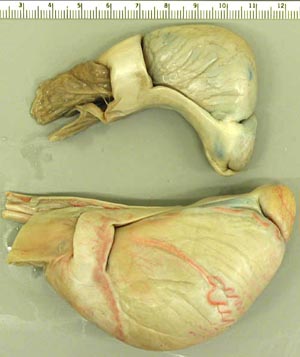 |
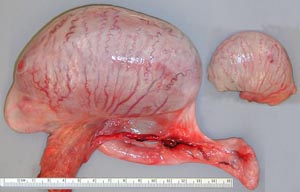 |
14 |
| 15 |  |
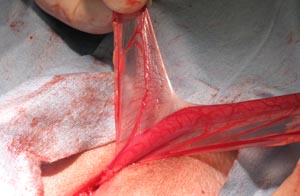 |
16 |
| 17 | 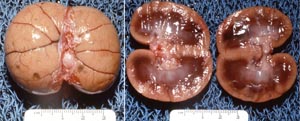 |
 |
18 |
| 19 | 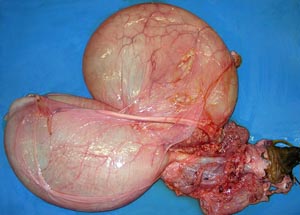 |
 |
20 |
